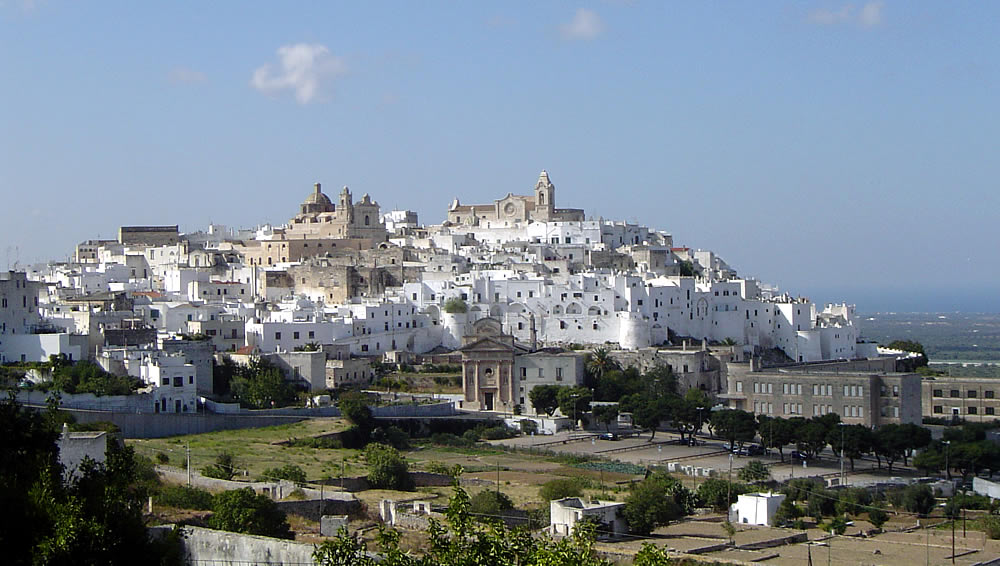Francesca Cavallo
Puglia, with its beautiful beaches and landscapes, stunning architecture and friendly people has become hugely popular as a holiday destination.
When most travelers think “Italian beach vacation,” they think of places like Portofino and Capri. Puglia is pretty much the exact opposite of those places and all the better for it. While the Italian Riviera and Amalfi Coast are well-groomed, glamorous, and sparkling, Puglia is rugged, simple, and totally laid-back. Its landscape, studded with farmhouses and miles of olive groves, reminds one of neighboring Greece. But its spirit remains 100 percent Italian. Located in the heel of Italy’s boot, Puglia is where Italians vacation. This summer I had the pleasure to visit this region, in particular my father’s hometown of Ostuni located about 11 km from the coast, in the province of Brindisi. This charming, fortified hill town is known as “la città bianca” (the white city) due to its whitewashed buildings and city walls, which give it a very exotic feel, more Greek or Middle Eastern than Italian.

The stark white of the town is broken up by some beautiful historical architecture, all of which stands out from its surroundings. The Messapii ancient Italian population founded the first nucleus of the city in seventh century BC on the top of a hill protected by walls, which also sheltered it from attacks, and provided for the construction of roads. Later, in third century BC, the Romans conquered it and today some Roman traces remain in farms built on the foundations of Roman villas. With the fall of the Western Roman Empire, Ostrogoths, Lombards, Saracens and Byzantines settled, in turn leaving visible traces of their occupation. The Aragonese created four-door access to the village of which today only the twelfth century Porta Nova is still evident, as well as the Thirteen Towers and Porta San Domenico, both built in the thirteenth century. With the Spanish rule in 1506, Ostuni began to experience a period of splendor by the granting of special favors by the Dukes. The decline of Ostuni began in the seventeenth century due to the debts incurred during the “Thirty Years War” (European conflicts from 1618 to 1648). King Philip IV of Habsburg sold it to the family Zevallos, merchants that then impoverished it. Moreover, the plague began to rage in the surroundings even if it did not directly strike the village, as the whitewash used to paint houses turned out to be a good and effective natural disinfectant. With the advent of the Bourbon dynasty in the eighteenth century, the city slowly began to flourish.
There are two parts of Ostuni: the Terra, the old town, and the Marina, the modern portion closer to the Adriatic sea, just 6 km away. Walking through old Ostuni from the bottom of the hill there is a baroque column nearly six stories tall that dominates the square and is topped with a statue of Ostuni’s patron saint, St. Oronzo. According to legend, the saint found refuge in a cave in Ostuni after he saved the population of the nearby coastal town of Salento from the plague that began in Naples.
From the square, the walk continues through the labyrinth of alleys, staircases and curved footpaths that lead us to small squares on multiple levels. At the top, there is a Gothic-style cathedral with its delicate rose window, which symbolizes the Cristo Sole. It is composed of three concentric circles, with 24 rays finely crafted, 12 concentric arches embellished with floral motifs and figures of the twelve apostles. At the center, surrounded by seven cherubs, is a figure of the Cristo Sole, master of the universe represented by the same rosette. It’s one of the few buildings that isn’t painted, but it’s still beautiful because of the way light reflects from its stone facade. In the square in front of the cathedral was the elegant arcade Arch of Incalzi, linking the Palazzo del Seminario and the Palazzo Vescovile. All cities and towns of Italy have their patron saints, so-called protectors, and it is an ancient tradition to have religious and public celebrations in their honor. Among all the year round number of feasts commemorating the patron saints in Italy, you do not want to miss the chance to attend the most grandiose and impressive one: the Cavalcata di Sant’Oronzo (Sant’Oronzo ride) in Ostuni. A three day festival is held in honor of Sant’Oronzo every year, beginning on the 25th of August. The festivities promise a cultural extravaganza in honor of the saint. The silver statue of the Patron is carried through the town by 40 riders on horseback, wearing costumes of an elegant red color, dotted with hand sewn sequins, which create a spectacular sight. There are knights, bishops and authorities that escort the statue. Beginning at the cathedral, the parade takes a journey right through the heart of the Piazza Sant’Oronzo. The festivities continue throughout the three days with a variety of food and beverages, until the festival finally concludes on the 27th of August, lighting up the sky with a colorful fireworks show. It is a special occasion indeed to not only appreciate the religious aspects of the region but also to have the opportunity to walk and admire an untainted natural area, its monastic buildings as well as its Mediterranean vegetation.
I deeply suggest you visit this majestic town. Lose yourself in the alleys, discovering step by step the history, the people and the monuments, with their Romanic and Gothic style influences. Last but not least, don’t forget to enjoy the amazing food and beaches.



